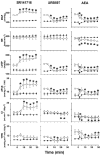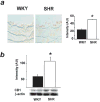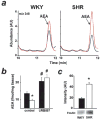Endocannabinoids acting at cannabinoid-1 receptors regulate cardiovascular function in hypertension
- PMID: 15451779
- PMCID: PMC2756479
- DOI: 10.1161/01.CIR.0000143230.23252.D2
Endocannabinoids acting at cannabinoid-1 receptors regulate cardiovascular function in hypertension
Abstract
Background: Endocannabinoids are novel lipid mediators with hypotensive and cardiodepressor activity. Here, we examined the possible role of the endocannabinergic system in cardiovascular regulation in hypertension.
Methods and results: In spontaneously hypertensive rats (SHR), cannabinoid-1 receptor (CB1) antagonists increase blood pressure and left ventricular contractile performance. Conversely, preventing the degradation of the endocannabinoid anandamide by an inhibitor of fatty acid amidohydrolase reduces blood pressure, cardiac contractility, and vascular resistance to levels in normotensive rats, and these effects are prevented by CB1 antagonists. Similar changes are observed in 2 additional models of hypertension, whereas in normotensive control rats, the same parameters remain unaffected by any of these treatments. CB1 agonists lower blood pressure much more in SHR than in normotensive Wistar-Kyoto rats, and the expression of CB1 is increased in heart and aortic endothelium of SHR compared with Wistar-Kyoto rats.
Conclusions: We conclude that endocannabinoids tonically suppress cardiac contractility in hypertension and that enhancing the CB1-mediated cardiodepressor and vasodilator effects of endogenous anandamide by blocking its hydrolysis can normalize blood pressure. Targeting the endocannabinoid system offers novel therapeutic strategies in the treatment of hypertension.
Figures







References
-
- Lew EA. High blood pressure, other risk factors and longevity: the insurance viewpoint. Am J Med. 1973;55:281–294. - PubMed
-
- Vollmer RR, Cavero I, Ertel RJ, et al. Role of the central autonomic nervous system in the hypotension and bradycardia induced by (-)-delta 9-trans-tetrahydrocannabinol. J Pharm Pharmacol. 1974;26:186–198. - PubMed
-
- Lake KD, Compton DR, Varga K, et al. Cannabinoid-induced hypotension and bradycardia in rats mediated by CB1-like cannabinoid receptors. J Pharmacol Exp Ther. 1997;281:1030–1037. - PubMed
-
- Benowitz NL, Jones RT. Cardiovascular effects of prolonged delta-9-tetrahydrocannabinol ingestion. Clin Pharmacol Ther. 1975;18:287–297. - PubMed
-
- Varga K, Lake K, Martin BR, et al. Novel antagonist implicates the CB1 cannabinoid receptor in the hypotensive action of anandamide. Eur J Pharmacol. 1995;278:279–283. - PubMed
MeSH terms
Substances
Grants and funding
LinkOut - more resources
Full Text Sources
Other Literature Sources
Medical

